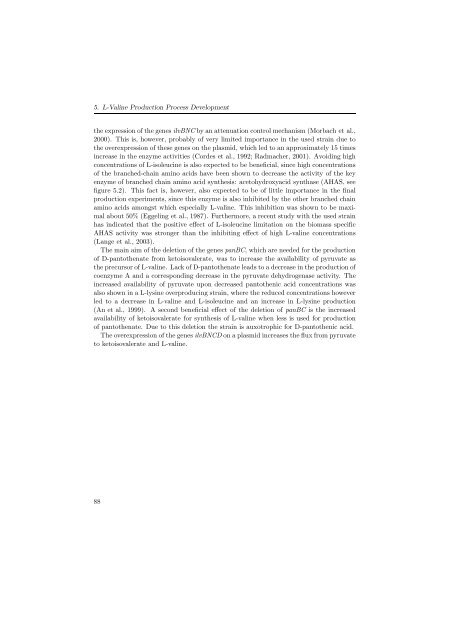Corynebacterium glutamicum - JUWEL - Forschungszentrum Jülich
Corynebacterium glutamicum - JUWEL - Forschungszentrum Jülich
Corynebacterium glutamicum - JUWEL - Forschungszentrum Jülich
You also want an ePaper? Increase the reach of your titles
YUMPU automatically turns print PDFs into web optimized ePapers that Google loves.
5. L-Valine Production Process Development<br />
the expression of the genes ilvBNC by an attenuation control mechanism (Morbach et al.,<br />
2000). This is, however, probably of very limited importance in the used strain due to<br />
the overexpression of these genes on the plasmid, which led to an approximately 15 times<br />
increase in the enzyme activities (Cordes et al., 1992; Radmacher, 2001). Avoiding high<br />
concentrations of L-isoleucine is also expected to be beneficial, since high concentrations<br />
of the branched-chain amino acids have been shown to decrease the activity of the key<br />
enzyme of branched chain amino acid synthesis: acetohydroxyacid synthase (AHAS, see<br />
figure 5.2). This fact is, however, also expected to be of little importance in the final<br />
production experiments, since this enzyme is also inhibited by the other branched chain<br />
amino acids amongst which especially L-valine. This inhibition was shown to be maximal<br />
about 50% (Eggeling et al., 1987). Furthermore, a recent study with the used strain<br />
has indicated that the positive effect of L-isoleucine limitation on the biomass specific<br />
AHAS activity was stronger than the inhibiting effect of high L-valine concentrations<br />
(Lange et al., 2003).<br />
The main aim of the deletion of the genes panBC, which are needed for the production<br />
of D-pantothenate from ketoisovalerate, was to increase the availability of pyruvate as<br />
the precursor of L-valine. Lack of D-pantothenate leads to a decrease in the production of<br />
coenzyme A and a corresponding decrease in the pyruvate dehydrogenase activity. The<br />
increased availability of pyruvate upon decreased pantothenic acid concentrations was<br />
also shown in a L-lysine overproducing strain, where the reduced concentrations however<br />
led to a decrease in L-valine and L-isoleucine and an increase in L-lysine production<br />
(An et al., 1999). A second beneficial effect of the deletion of panBC is the increased<br />
availability of ketoisovalerate for synthesis of L-valine when less is used for production<br />
of pantothenate. Due to this deletion the strain is auxotrophic for D-pantothenic acid.<br />
The overexpression of the genes ilvBNCD on a plasmid increases the flux from pyruvate<br />
to ketoisovalerate and L-valine.<br />
88

















